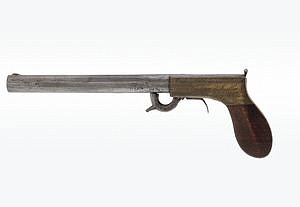"The less a man talks, the fewer lies he tells," was a saying that Emma Bell Miles attributed to Joe Winchester in "The Spirit of the Mountains," her 1905 book set on Walden's Ridge.
Among Winchester's favorite tales was the story of his friend Salola ("Squirrel" in Cherokee), with whom he camped and hiked over a period of six years. Both were woodworkers and blacksmiths who made tools, implements, and in Salola's case, weapons.
Most likely their friendship began after the Civil War. In the spring of 1848, Charles Lanham met Salola living among 800 Cherokees and a smaller number of Catawbas in Qualla Town (now Cherokee, N.C.). He described Salola as "quite a young man [with] a remarkably thoughtful face. He is the blacksmith of his nation, and with some assistance, supplies the whole of Qualla Town with all their axes and plows; but what is more, he has manufactured a number of very superior rifles and pistols, including stock, barrel and lock, and he is also the builder of grist mills, which grind all the meal his people eat. A specimen of his workmanship... may be seen at the Patent Office in Washington, where it was deposited by Mr. [William] Thomas; and I believe Salola is the first Indian who ever manufactured an entire gun."
Considering that Salola had never received instruction and used a flint-stone for an anvil and a water-blast for a bellows, Lanham wrote, "his attainments must be considered truly remarkable." At that time Salola spoke only Cherokee and communicated with his Catawba wife in a language of their own. "He is a most worthy man," Lanham concluded, and "an honor to the country." Today Salola's .28 caliber percussion pistol made of wood, brass and steel is displayed at the National Museum of American History in Washington, D.C.
Salola gained national attention again in 1852, when an article that William H. Thomas, the "white chief" of the Eastern Band, submitted to the Asheville News was reprinted in the New York Daily Times. Salola had captured a dark-colored rattlesnake with 10 rattles and two forked horns about three quarters of an inch long on its head that he described as "a king among snakes of its species."
Salola, who died in 1895, was roughly a contemporary of Joe Winchester. Their primary interest was searching for a lost silver mine that had been worked by the Indians before they left Tennessee. They took long camping trips in wild areas of the Suck and the Horseshoe on Walden's Ridge. Once they discovered a cave containing primitive tools and a pole ladder. On another search they stumbled upon a cave with picture-writing, arrowheads, potsherds and a fire pit possibly used to work metal or smelt ore. But they never found the old silver mine, which they thought would be nearby.
Winchester's sons predicted he would reveal the location of these caves, but the old man died suddenly - without even telling them where he got his ample supply of lead.
Cartter Patten retold the story in "Signal Mountain and Walden's Ridge" (1962), adding information gleaned from mountain man Joe Miles, that the rock house where Winchester and Salola found the crude tools and ladder was on a tributary of Suck Creek. Both Miles and Patten describe a hunter's discovery of a spot where a "deer's hoof had scraped a vein of gray metal that looked like lead as it ran towards the headwaters of Suck Creek."
"Geologists see little hope of finding either lead or silver on Walden's Ridge," Patten wrote, suggesting Winchester's lead could have come from the Union wagon train Wheeler's cavalry burned in October 1863.
"Every field geologist who has worked in the Southern Appalachians or the Ozarks is familiar with the legend of 'Grandpappy's lost lead mine' known only to him and sometimes an old Indian," Robert A. Laurence wrote in the October 1963 "Journal of the Academy of Science," but "galena in small quantities is widespread and easily smelted at a relatively low temperature. A few pounds of lead would last a long time if used only for bullets... and other domestic uses."
As for cave art, glyph caves related to Mississippian occupation in the Tennessee Valley continue to be discovered, archaeologist Charles H. Faulkner wrote in 1997. To those would take up the quest, Emma Bell Miles recorded Joe Winchester's response: "If you'uns want a mine, you're jist as welcome to hunt for hit as I was."
Kay Baker Gaston is a regional historian and former Chattanoogan. For more, visit Chattahistoricalassoc.org.
